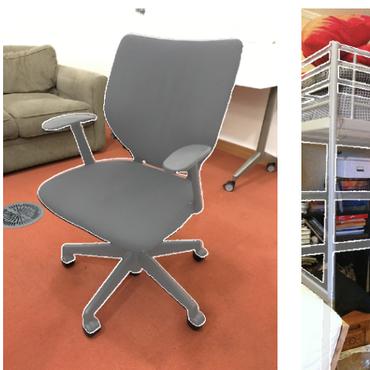Search Results for author: Biao Leng
Found 12 papers, 3 papers with code
Unifying Visual Perception by Dispersible Points Learning
1 code implementation • 18 Aug 2022 • Jianming Liang, Guanglu Song, Biao Leng, Yu Liu
The method, called UniHead, views different visual perception tasks as the dispersible points learning via the transformer encoder architecture.
Self-slimmed Vision Transformer
1 code implementation • 24 Nov 2021 • Zhuofan Zong, Kunchang Li, Guanglu Song, Yali Wang, Yu Qiao, Biao Leng, Yu Liu
Specifically, we first design a novel Token Slimming Module (TSM), which can boost the inference efficiency of ViTs by dynamic token aggregation.
RCNet: Reverse Feature Pyramid and Cross-scale Shift Network for Object Detection
no code implementations • 23 Oct 2021 • Zhuofan Zong, Qianggang Cao, Biao Leng
Moreover, semantics from non-adjacent levels are diluted in the feature pyramid since only features at adjacent pyramid levels are merged by the local fusion operation in a sequence manner.
Self-Slimming Vision Transformer
no code implementations • 29 Sep 2021 • Zhuofan Zong, Kunchang Li, Guanglu Song, Yali Wang, Yu Qiao, Biao Leng, Yu Liu
Specifically, we first design a novel Token Slimming Module (TSM), which can boost the inference efficiency of ViTs by dynamic token aggregation.
RaidaR: A Rich Annotated Image Dataset of Rainy Street Scenes
no code implementations • 9 Apr 2021 • Jiongchao Jin, Arezou Fatemi, Wallace Lira, Fenggen Yu, Biao Leng, Rui Ma, Ali Mahdavi-Amiri, Hao Zhang
We introduce RaidaR, a rich annotated image dataset of rainy street scenes, to support autonomous driving research.
KPNet: Towards Minimal Face Detector
no code implementations • 17 Mar 2020 • Guanglu Song, Yu Liu, Yuhang Zang, Xiaogang Wang, Biao Leng, Qingsheng Yuan
The small receptive field and capacity of minimal neural networks limit their performance when using them to be the backbone of detectors.
Rethinking Loss Design for Large-scale 3D Shape Retrieval
no code implementations • 3 Jun 2019 • Zhaoqun Li, Cheng Xu, Biao Leng
In this paper, we propose the Collaborative Inner Product Loss (CIP Loss) to obtain ideal shape embedding that discriminative among different categories and clustered within the same class.
Angular Triplet-Center Loss for Multi-view 3D Shape Retrieval
no code implementations • 21 Nov 2018 • Zhaoqun Li, Cheng Xu, Biao Leng
How to obtain the desirable representation of a 3D shape, which is discriminative across categories and polymerized within classes, is a significant challenge in 3D shape retrieval.
Learning Discriminative 3D Shape Representations by View Discerning Networks
2 code implementations • 11 Aug 2018 • Biao Leng, Cheng Zhang, Xiaocheng Zhou, Cheng Xu, Kai Xu
In this network, a Score Generation Unit is devised to evaluate the quality of each projected image with score vectors.
Beyond Trade-off: Accelerate FCN-based Face Detector with Higher Accuracy
no code implementations • CVPR 2018 • Guanglu Song, Yu Liu, Ming Jiang, Yujie Wang, Junjie Yan, Biao Leng
Fully convolutional neural network (FCN) has been dominating the game of face detection task for a few years with its congenital capability of sliding-window-searching with shared kernels, which boiled down all the redundant calculation, and most recent state-of-the-art methods such as Faster-RCNN, SSD, YOLO and FPN use FCN as their backbone.
Region-based Quality Estimation Network for Large-scale Person Re-identification
no code implementations • 23 Nov 2017 • Guanglu Song, Biao Leng, Yu Liu, Congrui Hetang, Shaofan Cai
One of the major restrictions on the performance of video-based person re-id is partial noise caused by occlusion, blur and illumination.
Weakly-supervised Learning of Mid-level Features for Pedestrian Attribute Recognition and Localization
no code implementations • 17 Nov 2016 • Kai Yu, Biao Leng, Zhang Zhang, Dangwei Li, Kaiqi Huang
Based on GoogLeNet, firstly, a set of mid-level attribute features are discovered by novelly designed detection layers, where a max-pooling based weakly-supervised object detection technique is used to train these layers with only image-level labels without the need of bounding box annotations of pedestrian attributes.










